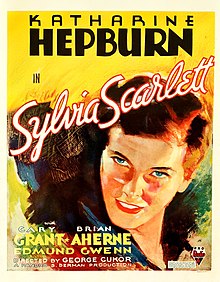
Cary Grant was an English-American actor known for his Mid-Atlantic accent, debonair demeanor, lighthearted approach to acting, and sense of comedic timing. He was one of classic Hollywood's definitive leading men. He was nominated twice for the Academy Award, received an Academy Honorary Award in 1970, and received the Kennedy Center Honor in 1981. He was named the second greatest male star of the Golden Age of Hollywood by the American Film Institute in 1999.

Katharine Houghton Hepburn was an American actress whose career as a Hollywood leading lady spanned six decades. She was known for her headstrong independence, spirited personality, and outspokenness, cultivating a screen persona that matched this public image, and regularly playing strong-willed, sophisticated women. Her work was in a range of genres, from screwball comedy to literary drama, and earned her various accolades, including four Academy Awards for Best Actress—a record for any performer. In 1999, Hepburn was named the greatest female star of classic Hollywood cinema by the American Film Institute.
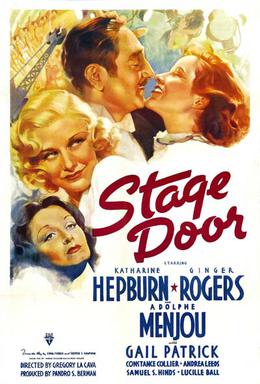
Stage Door is a 1937 American drama film directed by Gregory La Cava. Adapted from the play of the same name, it tells the story of several would-be actresses who live together in a boarding house at 158 West 58th Street in New York City. The film stars Katharine Hepburn, Ginger Rogers, Adolphe Menjou, Gail Patrick, Constance Collier, Andrea Leeds, Samuel S. Hinds and Lucille Ball. It was produced and distributed by RKO Pictures. Eve Arden and Ann Miller, who became notable in later films, play minor characters.
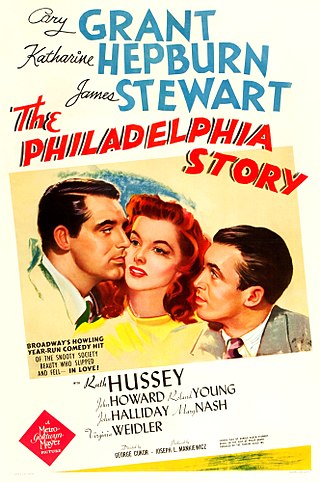
The Philadelphia Story is a 1940 American romantic comedy film starring Cary Grant, Katharine Hepburn, James Stewart, and Ruth Hussey. Directed by George Cukor, the film is based on the 1939 Broadway play of the same name by Philip Barry, about a socialite whose wedding plans are complicated by the simultaneous arrival of her ex-husband and a tabloid magazine journalist. The socialite, played by Hepburn in both productions, was inspired by Helen Hope Montgomery Scott (1904–1995), a Philadelphia heiress known for her hijinks, who married a friend of playwright Barry.

Bringing Up Baby is a 1938 American screwball comedy film directed by Howard Hawks, and starring Katharine Hepburn and Cary Grant. It was released by RKO Radio Pictures. The film tells the story of a paleontologist in a number of predicaments involving a scatterbrained heiress and a leopard named Baby. The screenplay was adapted by Dudley Nichols and Hagar Wilde from a short story by Wilde which originally appeared in Collier's Weekly magazine on April 10, 1937.
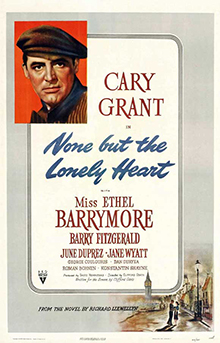
None but the Lonely Heart is a 1944 American drama romance film which tells the story of a young Cockney drifter who returns home with no ambitions but finds that his family needs him. Adapted by Clifford Odets from the 1943 novel of the same title by Richard Llewellyn and directed by Odets, the movie stars Cary Grant, Ethel Barrymore, and Barry Fitzgerald.

Morning Glory is a 1933 American Pre-Code drama film which tells the story of an eager would-be actress and her journey to stardom, and her gains and losses. The picture stars Katharine Hepburn, Douglas Fairbanks Jr., and Adolphe Menjou, was adapted by Howard J. Green from a then-unproduced stage play of the same name by Zoë Akins, and was directed by Lowell Sherman. Hepburn won her first Academy Award for Best Actress for this movie. Morning Glory was remade in 1958 under the title Stage Struck.

Mary of Scotland is a 1936 American historical drama film starring Katharine Hepburn as the 16th-century ruler Mary, Queen of Scots. Directed by John Ford, it is an adaptation of the 1933 Maxwell Anderson play, with Fredric March reprising the role of Bothwell, which he also performed on stage during the run of play. The screenplay was written by Dudley Nichols. Ginger Rogers wanted to play this role and made a screen test, but RKO rejected her request to be cast in the part feeling that the role was not suitable to her image.
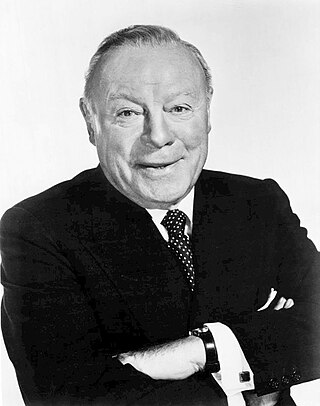
Edmund Gwenn was an English actor. On film, he is best remembered for his role as Kris Kringle in the Christmas film Miracle on 34th Street (1947), for which he won the Academy Award for Best Supporting Actor and the corresponding Golden Globe Award. He received a second Golden Globe and another Academy Award nomination for the comedy film Mister 880 (1950). He is also remembered for his appearances in four films directed by Alfred Hitchcock.

Little Women is a 1933 American pre-Code drama film directed by George Cukor, and starring Katharine Hepburn, Joan Bennett, Frances Dee, and Jean Parker. The screenplay, written by Sarah Y. Mason and Victor Heerman, is based on the 1868-1869 two-volume novel of the same name by Louisa May Alcott.
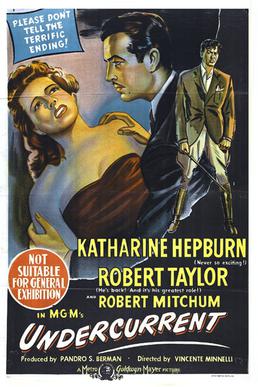
Undercurrent is a 1946 American film noir drama directed by Vincente Minnelli and starring Katharine Hepburn, Robert Taylor, and Robert Mitchum. The screenplay was written by Edward Chodorov, based on the story "You Were There'" by Thelma Strabel, and allegedly contained uncredited contributions from Marguerite Roberts.
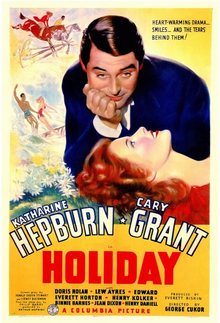
Holiday is a 1938 American romantic comedy film directed by George Cukor, a remake of the 1930 film of the same name.

In Name Only is a 1939 romantic film starring Cary Grant, Carole Lombard, and Kay Francis, directed by John Cromwell. It was based on the 1935 novel Memory of Love by Bessie Breuer. The fictional town where it is set, Bridgefield, Connecticut, is based on the town of Ridgefield, Connecticut.
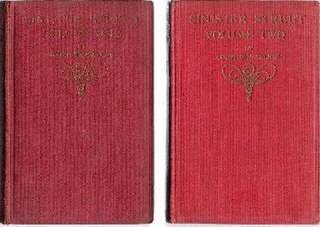
Sinister Street is a 1913–1914 novel by Compton Mackenzie. It is a kind of Bildungsroman or novel about growing up, and concerns two children, Michael Fane and his sister Stella. Both of them are born out of wedlock, something which was frowned upon at the time, but to rich parents.

Bernard Newman was the head designer for Bergdorf Goodman and head costume designer for RKO Pictures. He designed costumes for some 35 movies, dressing stars including Ginger Rogers, Katharine Hepburn, Lucille Ball and Helen Broderick. He was posthumously included in the Costume Designers Guild Hall of Fame in 2004.
Mel Berns was an American make-up artist. He was the Head of Makeup at RKO Pictures for more than twenty years.
Katharine "Kay" Brown Barrett was a Hollywood talent scout and agent beginning in the 1930s. She is most famous for bringing Margaret Mitchell's novel Gone with the Wind to the attention of David O. Selznick, for whom she worked, in 1936. She had a long career as representative, talent scout and agent with Leland Hayward, MCA and International Creative Management ("ICM").
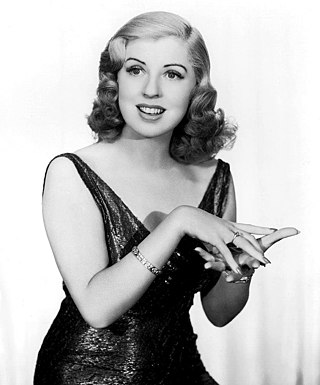
Dennie Moore was an American film and stage actress.
Jane Loring (1890–1983) was an American film editor and producer active during the 1920s through the 1940s. She was related to screenwriter Hope Loring.
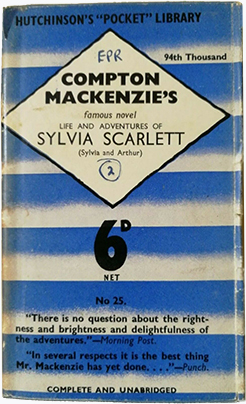
The Early Life and Adventures of Sylvia Scarlett, often shortened to Sylvia Scarlett, is a 1918 novel by the British writer Compton Mackenzie. The heroine of the story had previously appeared in Mackenzie's Sinister Street. It was followed by a sequel Sylvia and Michael in 1919.
